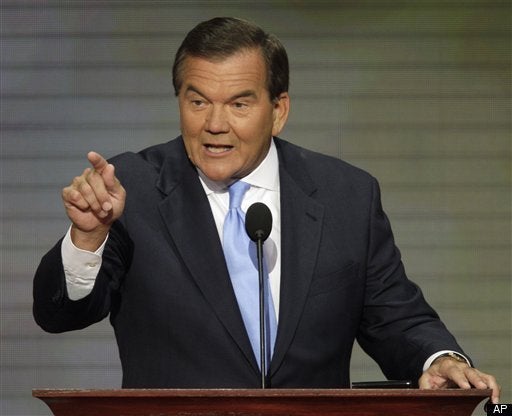
Yesterday's revelation from former Secretary of Homeland Security Tom Ridge that he was pressured to raise the terror alert level to assist President George W. Bush win re-election in 2004 was widely greeted by Bush critics as the confirmation of longstanding suspicions. And everyone who contended that the silly Terror Color Chart could have not possibly served any other purpose than a political one should take a victory lap, right? Atlantic's Marc Ambinder didn't seem to think so (at least not at first), telling his readers:
Journalists, including myself, were very skeptical when anti-Bush liberals insisted that what Ridge now says is true, was true. We were wrong. Our skepticism about the activists' conclusions was warranted because these folks based their assumption on gut hatred for President Bush, and not on any evaluation of the raw intelligence. But journalists should have been even more skeptical about the administration's pronouncements.
I can do very little to add what Marcy Wheeler and Glenn Greenwald have contributed to the discussion, nevertheless I feel the need to get a few licks in about Ambinder's prejudice. What Ambinder needs to admit, here -- and he is not alone -- is that he erred in assuming that skepticism about Bush's conduct only originated from "gut hatred of Bush." Certainly, some did. But, Ambinder's view completely eliminates the possibility that skepticism could originate from reason or from seriousness.
This is the difference between, say, skepticism that the Obama administration has not provided sufficient oversight of TARP -- versus skepticism that Obama is an American citizen.
Ridge's confession also reminds us about our colorful terror alert chart, and its colorful history. Most of our experience with the Terror Alert System came from periodic vacillations between the yellow "Elevated" level and the orange "Guarded" during the Bush years. The alert level escalations were rarely specific in terms of providing useful information to American citizens. Most, in fact, had to do with vague feelings of unease over anniversaries, holidays, and events abroad. Consider:
--September 11, 2002, the Terror Alert was raised to Orange because of the 9/11 Anniversary
--February 7, 2003, the alert level was raised because the end of a Muslim religious holiday threatened "apartment buildings, hotels, and other soft or lightly secured targets," for some reason.
--March 17, 2003, we went to war with Iraq, so it was time to raise the alert level!
--May 20, 2003, raised in response to bombings in Riyadh and Casablanca
--December 2003 through January 2004, the alert level was raised because of vague suspicions of threats associated with the Christmas holiday.
--July 7, 2005: The Terror Alert level is raised in response to the London Underground bombings.
--August 10, 2006: The one occasion where the Alert Level was raised to Red, in response to the news that British officials had thwarted an attack. The alert level stayed Red for four days, and applied only to flights emanating from the United Kingdom.
And then there was the one instance in which the description of the threat was curiously specific: In August of 2004, just days after the Democratic National Convention, and
three months before the general election, Homeland Security warned of "possible terrorist attacks against "iconic" financial institutions in New York City, Washington and Newark, N.J., saying a confluence of intelligence over the weekend pointed to a car or truck bomb." Specific buildings were listed as potential targets. It stood out as a uniquely useful alert. It was also, complete bunk:
Even the Washington Post indicated as much at the time. From August 4, 2004:
Bush administration officials acknowledged yesterday that the latest terrorism alert was based primarily on information that is three to four years old, but they aggressively defended the decision to warn financial sectors in Washington, New York and Newark because of the continuing threat posed by al Qaeda.
[...]
...authorities did not publicly make it clear until yesterday that the information compiled during that surveillance, contained on computer disks and documents seized during raids in Pakistan, was created in
2000 and 2001 or, in some cases, undated. Much of the information was also obtained from the Internet or other public sources, officials said.Authorities issued somewhat conflicting signals yesterday about the timing of the surveillance. Frances Fragos Townsend, the White House deputy national security adviser for terrorism, said in a television
interview that "the casings were done in 2000 and 2001." Ridge said the information "might be two or three years old," adding that "there's no evidence of recent surveillance."
By contrast, in 2005, the Bush administration received actionable, current intelligence about al Qaeda efforts to set up a "terrorist cell in Iraq to strike targets in America." But in this case, the administration's response was very different:
As the Associated Press reported in 2007:
Bush said intelligence showed that in January 2005, bin Laden tasked Abu Musab al-Zarqawi, his senior operative in Iraq, to organize a terrorist cell and use Iraq as a staging ground for attacking the United States.
This information expanded on a classified bulletin the Homeland Security Department issued in March 2005. The bulletin, which warned that bin Laden had enlisted al-Zarqawi to plan potential strikes in the United States, was described at the time as credible but not specific. It did not prompt the administration to raise its national terror alert level.
When you really examine the confused and often out-of-sync way the terror alert device was misapplied, the overall disingenuousness at work is readily discernible to anyone with a brain. It's not a product of Bush derangement syndrome. By applying rudimentary scrutiny, it is impossible to conclude that this system was not blatantly manipulated for political purposes. And now, thanks to Tom Ridge, former Secretary of Homeland Security, this purpose has been confirmed. To continue to believe otherwise -- in the face of logic, history, and Ridge's admission -- is to be, as they say, "bats," and it's time for journalists to consider recalibrating their definitions of who is, and who isn't, "serious."
[Would you like to follow me on Twitter? Because why not? Also, please send tips to tv@huffingtonpost.com -- learn more about our media monitoring project here.]
